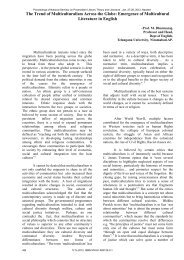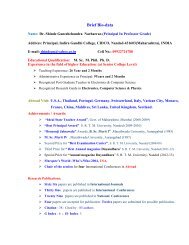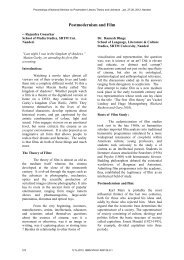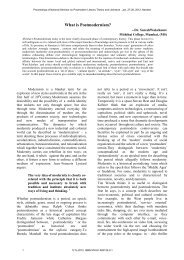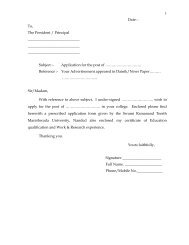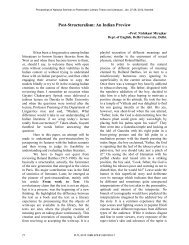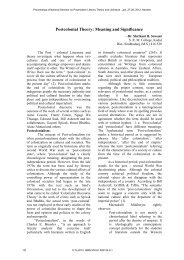Postcolonial Feminist Theory: An Overview - Igcollege.org
Postcolonial Feminist Theory: An Overview - Igcollege.org
Postcolonial Feminist Theory: An Overview - Igcollege.org
Create successful ePaper yourself
Turn your PDF publications into a flip-book with our unique Google optimized e-Paper software.
Proceedings of National Seminar on Postmodern Literary <strong>Theory</strong> and Literature , Jan. 27-28, 2012, Nandedreligious prejudices against the untouchables, the autobiography gives some of the most memorablepictures of dalit women facing the vicissitudes of life bravely. Though the book has a plethora offemale characters, the most important women character in the novel is Santamai, the grand mother ofthe narrator. The narrator is so much attached with her that instead of his monther Masamai, lieprefers to live with her: "Masarnai, my mother, always treated me as if I were her step son. I wasmore attached to Shantamai , my grandmother. Whenever Masamai began to hit me Shantamai wouldintervene and save me." 6 She too treats him like her own son and undergoes great hardships to bringhim up and educate him. Whenever the narrator does something outstanding, she feels proud of him.Very early in the navel when Sharan goes in a procession with other school boys on Republic day,Shantamai feels "her dream liad come true" (p. 6). Shantamai is an ordinary dalit women, who hasbeen described in no flattering terms: "Her mouth smelt foul and her teeth had turned quite baick fromthe herbal powder she-used to clean them with" (p. 6-7). She gathers dung for making cakes of dungto sell them. Due to her hard work and constant starvation her skin has dried up and shriveled. Sheherself eats bhakaris made out of the jowar grains washed out of the dung of animals and gives Sharanbhakaris out of the floor collected as alms. Once when the narrator insists on eating the bhakariswhich Shantamai used to eat, lie feels nauseated. Constant hunger and deprivation has made herimmune to the stink of the dung in the bhakries: "Shantamai ate those bhakris as a matter of course,her blackened teeth turning those bhakaris into pulp. |... She gave no sign of being assaulted by thestink of dung. She just pushed it into her mouth and it went down her stomach, whereas the dungheaved up in mine" (R 11). The description, on the one hand, brings out the mute, expressionless lovein Shantamai for her grandson whom she gives the bhakaris made of better flour while slie herself eatsthe bhakaris made up grains collected from dung, on (lie other Sliaiitamai's indifference to the smellof dung presents her as a woman who has been treated so inhumanly by the caste system throughouther life that she has now 'naturalized' to the conditions. She shares a very thorny existence witli dada,her muslim partner, and the narrator, perhaps more difficult than her male counterparts. It is she whohas to bear the burden of begging, sweeping and arranging for the survival of her family. When sliequarrels with Masamai on account of the narrator, she leaves the house and starts living at the busstand with the narrator and dada. Whenever the narrator felt hungry, Shantamai begged Bkakari forhim. When Sharan was a little baby, she used to tie him to her back while sweeping the village streets.Her attachment to the narrator is genuine and deep. She has no affectations and is withoutostentatious feelings. Her love for the narrator is laced with the authentic feeling towards him. Oncewhen the narrator brings his friends to her, she gives them whateve she could spare. Later when thereis only one bhakari left she give it to the narrator pretending that they have flour in the tin box. Aftereating it, the narrator discovers that the tin box had no flour but a stone which Shantamai had putthere so that the narrator could eat comfortably, because they had nothing for themselves. When tshegoes to meet the narrator in the city, despite her poverty she doesn’t f<strong>org</strong>et to take beef with her whichwas greatly like by the narrator.348 PLTL-2012: ISBN 978-81-920120-0-1



